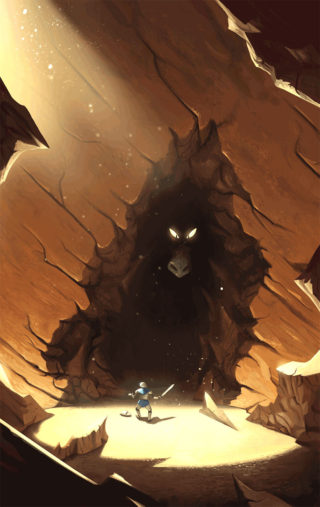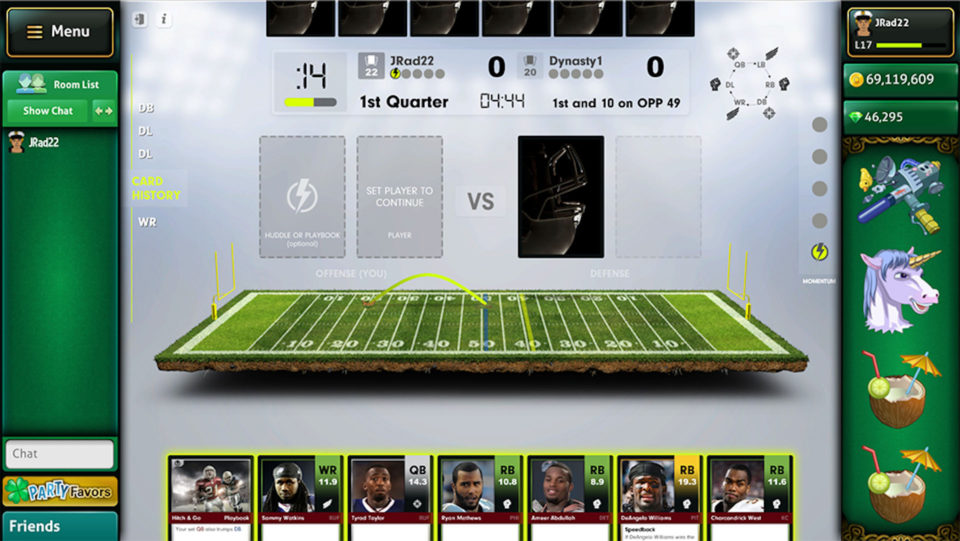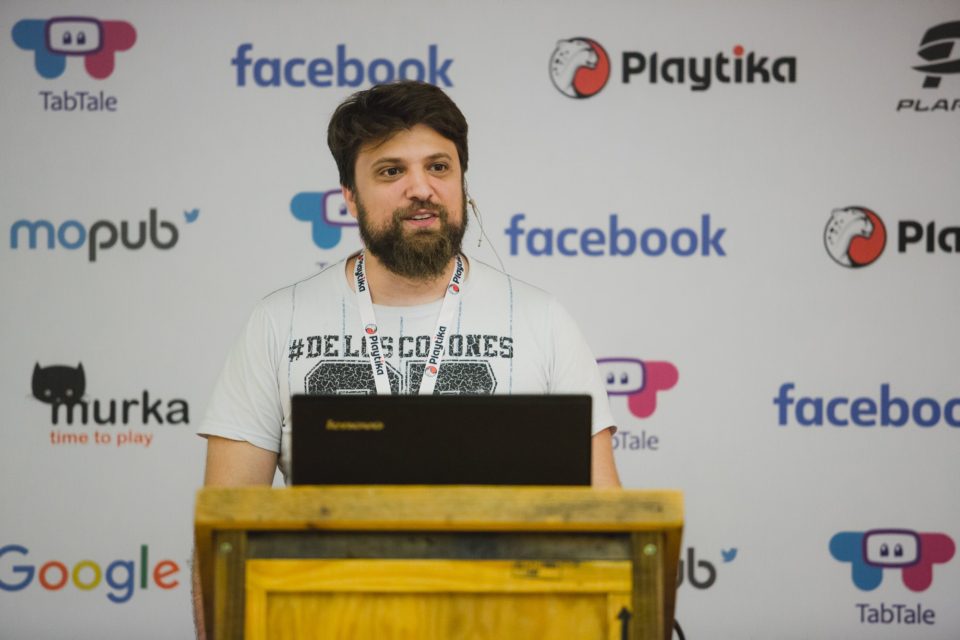Does paid marketing make sense in scaling your game? In a talk at Casual Connect Asia, Martin Macmillan (CEO of Pollen Velocity Capital) called How to Scale Your Game: Understanding the Metrics and How to Act on Them, Martin explained exactly that. He advised, “Here is a bit of marketing 101: unless you have figured out a way to spend profitably, you shouldn’t spend at all because mathematically you’re setting out to lose money.” First and foremost, possessing a good understanding of LTV is a must. Then you need to understand if the unit economics work in order to use paid UA as a viable marketing channel. To learn more about what your game’s metrics can tell you and how to finance growth, tune in to Martin’s full session below.
main
BusinessExclusive Interviews
How FlowPlay Built a Social Sports Wagering Dynasty
FlowPlay has launched Dynasty Football, an online fantasy football strategy card game. Designed to appeal to both fans of collectible card games and fantasy football enthusiasts, this unique game blends the real-world player stats of fantasy football with the excitement of head-to-head card battles.
“Collectible card games have become increasingly popular over the last two years, and we saw an opportunity to bring our expertise in casual fantasy sports games to this growing market,” said Derrick Morton, CEO of FlowPlay. “We’re one of the first to introduce sports elements into the digital card games genre, allowing us to expand the appeal of Dynasty Football to the broader audience of 60 percent of the U.S. population that considers themselves sports fans, according to Gallup.”
BusinessContributionsIndustry
Game of Zones: How to Conquer Every Crowd
By: Adi Haddad, Head of Marketing at Ilyon
Not quite friends, but certainly not enemies, the United States and China have vastly different cultures – but despite that, both sides try their best to trade and promote their country’s products and technologies in each other’s markets. Some American brands – like Apple, Coca Cola – have done well in China, while several Chinese brands, like Huawei and ZTE, are recognized by American consumers for their technology, not just the low prices that Chinese products are usually associated with.

But there have been far more misses than hits for both in the other side’s markets – especially in technology. Ebay, for example, has struggled in the Far East, while WeChat, the Chinese all-around chat and e-commerce app, has yet to make inroads in the US. Why? Both missed important cultural or usage cues that consumers in each country were looking for. Chinese consumers preferred local online auction apps because they allowed them to instantly communicate with sellers (something eBay didn’t offer), while in the US, WeChat failed (or chose not) to make deals with other app makers or services like it has done in China. As a result, American WeChat users remained in the closed environment of the app, unable to use it to order meals or other products directly from chat, or tweet a photo taken using WeChat.
The differences in the way the American and Chinese markets work are just one example of how even in a fully interconnected world – with instant communications and nearly instant travel options – cultures and countries still retain independent identities, to the extent that marketers who failed to recognize just how different the world outside their neighborhood really is lost valuable time and money before realizing that they were a lot less well-informed than they should have been before foraying outside familiar territory.
Tel Aviv 2016Video Coverage
Hernan Lopez and the Emerging LATAM Market

Are you looking for a new and growing market for games? Latin America might be the place to consider according to Hernan Lopez, Founder and warchief of Epic Llama Games. Hernan founded the company in 2008 and focused on the casual games market. Their latest game is Darkestville Castle, a graphic adventure reminiscent of such classic games as Monkey Island and Grim Fandango.
Hernan epitomizes passion for games and dedication to the games industry, and as such, is eager to encourage game developers to follow their own passion. And the LATAM market is an excellent place to gain a foothold. Although it is largely unexplored, it is also growing and new developers are starting to emerge. At Casual Connect Tel Aviv, Hernan discussed this market and why it the game industry should be paying attention to it. Hernan explained, “APAC is the hot topic today, so LATAM can get overlooked. Don’t underestimate LATAM as a great region for soft-launching your games; it isn’t heavily contested but it’s influenced by U.S. and European culture. You’ll also be surprised at the budding developer community there.” To learn more, watch this video of the full presentation.
DOWNLOAD SLIDES
For more information about Hernan’s career, see this exclusive article.
ContributionsDevelopmentIndustry
ZPLAY Participates in Casual Connect: Committed to the Globalization Strategy
Casual Connect USA will be held in San Francisco on 18th-20th July 2016. Talents in casual games will gather here, displaying a diversified window in the game industry. ZPLAY, with its popular mobile games PopStar! Official Version, BBTAN, Daddy Long Legs and new games BBTAN 2, Inner Circle, etc. will participate at Casual Connect USA, focusing on its diversified formats within game industry with game developers all over the world.
USA 2014Video Coverage
Lea Gulino Looks to Bridge the Gap | Casual Connect Video
Lea Gulino talked about working with voice talent at Casual Connect USA 2014. “You don’t have to be an actor to get caught up in the energy of a scene,” she explained. “Lose your inhibitions. Allow yourself to nod or make eye contact through the glass to the actor. Being able to play around a little bit will create a trust, it will create an engagement and creative sparks will fly.”
Lea Gulino is a voice actor and independent contractor who has watched technology open up many more opportunities in the games industry, especially for newcomers and startups, but notes that with so many people in the pool, it’s easier to drown. So it is essential to find a way to stand out. She feels social media is an accessible and effective way to get the word out, and that, if you commit, you can find an audience. Ultimately, the game must be unique, attractive and engaging, but that becomes increasingly difficult as the community grows and ideas continue to be regurgitated. She emphasizes the need to focus on production values and writing, pointing out that a pro voice actor can help pull it all together.
Many indie developers have never worked with actors before. Gulino is attempting to bridge the gap between the two by attending conferences like Casual Connect, where they can share each other’s processes, strengths, and needs and to invest in each other to produce the best product possible.
Bringing Characters To Life
Gulino is involved in a wide variety of projects. Besides games, she works with audiobooks, training guides, and radio spots. She even is the person you hear saying, “Your call is being recorded for training and quality purposes.”
She says she especially loves gaming session work, bringing characters to life for developers. She has lived in many places and has a theater degree from New York University, so she blends gypsy and thespian approaches, based on her training and travels, when developing characters.
And she loves the variety, not knowing what to expect when she shows up for a session. She could be given two, three, or four different characters, all with different accents and different attitudes; the work is intense, keeping her constantly on her toes. She believes, “There’s no form of acting that offers such diversity in the same day. The closest is probably the theater, which is where I began, so it really takes me back to my roots.”
Lady Liberty
But when considering her very diverse career, she believes the proudest moment was definitely recording the Family Audio Tour for the Statue of Liberty. She lived in New York for many years, and her grandparents came through Ellis Island. She says, “Passing Lady Liberty as they entered New York Harbor must have meant so much to them, marking the end of such a long journey and the beginning of another. It makes me feel good that a little part of me is on that island every day, guiding around thousands of school children.”
Gulino describes herself as a classic casual mobile gamer. She is playing a lot of Dots on her iPhone and jumps around between Tap Tap Revenge, Word Wrap, Moxie, Bejeweled Blitz, and Tilt World. She also admits to being obsessed with last year’s Most Promising Indie winner, Lost Toys. And she tries to get in a few games of Conundra before bed; she claims it is seriously improving her math skills.
Games Go Global
During the next few years, Gulino expects to see the games industry continuing to go global; already incredible developers are found in every corner of the globe. Boundaries are becoming blurred and cultural points of view are blended as like-minded people find each other through social media and international conferences, such as Casual Connect. It is exciting to see these people connect and decide to build a game together, despite living in completely different cities. She has now begun working with agencies based in Amsterdam and London, as well as upgrading her sound system, since she is patching in more and more sessions from her home studio.
Gulino’s home studio is aboard a big old wooden boat that keeps her busy and gives her incredible perspective of the Bay area. She loves the museums and theaters in the region, and also enjoys golf and biking. A special interest is cooking with the fresh organic foods available locally, alleging, “It’s amazing what creations come out of my little galley.”
USA 2014Video Coverage
Barbara Chamberlin’s Insatiable Learning Quest | Casual Connect Video
Barbara Chamberlin shared her views on user testing during Casual Connect USA 2014. “The personal epiphany I had was not to resent user testing every time I had to do it, but to find a way to make it easy,” she said.
Barbara Chamberlin is the director of the New Mexico State University Learning Games Lab. For almost 20 years, she has been developing games for learning. Because she has always hated user testing, she has focused her research on finding more efficient and enjoyable ways to get the kind of feedback from kids that will make learning games better.
As a parent of two children, Chamberlin naturally spends considerable time involved with their activities, such as 4H meetings and swimming practice. She also downloads many children’s apps and finds it exciting to review, play, and discuss them with her children. She brings to her work the advantage of constantly being reminded of how children learn and how things that are mundane to adults are exciting new discoveries for kids.
Learning and Experience
Chamberlin describes herself as insatiable, constantly wanting to learn more, see more, and experience more. In her work, the results of her research immediately spark new questions. When a new construct is implemented, she enjoys thinking of other ways it could be used, and hearing about something new carries with it the desire to learn more.
The best part of working in this industry for Chamberlin is the opportunity to learn about a wide variety of different things. She sees her work as education rather than gaming; everything they create is based on research and has education or behavior change as the end goal. She insists that, although the concepts their games teach may sound boring, the content is vital to a student’s success, so it is equally necessary to do a good job helping kids learn it. “When you really understand how essential this is, it is exciting to realize how much potential you have as a designer,” she claims. “That’s the best part. We’re changing lives here, in small, incremental, but incredibly important ways.”
The Power Of Interactivity
Twenty years ago, when she was creating interactive touch screen kiosks for public environment, she realized the power of interactivity for learning, and thought, “It should all be like this.” So she has spent her career at NMSU figuring out educational gaming and seeing it evolve and grow. Recently, she has seen an increase in great educational games and public acceptance of educational game play. She maintains, “Just as every game developer should be a game player, so should every learning games developer be a learning researcher. We can do so much more than make quiz games for learning; we can change behavior, alter mindsets, influence emotions and really empower inquiry. I’m excited to see the industry moving in those directions.”
The Monetization Challenge
The most serious challenge Chamberlin sees facing the games industry today is the monetization of casual games. While she realizes game development is a business, she also recognizes that we now know so much about human behavior that we can tweak every impulse and scientifically manipulate each person to spend, contribute, and buy. Unfortunately, it also makes the game less fun, and, she says, “It doesn’t do much for society either.” These games may distract the user and tickle the part of the brain that responds to incentives, but players’ lives are not made richer from the experience. She would much prefer to see people make money by crafting beautiful, engaging, and enriching experiences.
Chamberlin does not face the issue of monetization directly, since most of her work is grant-funded and does not have to show a profit, yet they — like many developers of educational games — are still looking for a viable model for disseminating, promoting and maintaining their apps, once developed.
In this competitive space, many educational developers still face the challenge of promoting and disseminating their games into classrooms and to learners. One of biggest questions in the educational gaming right now, according to Chamberlin, is the school-based dissemination of learning software. Everyone in the industry is trying to anticipate how teachers and parents find and buy apps, how schools decide what systems to use, and how children engage in the apps most specific to their needs. She says, “We are still trying to predict the best way to get effective learning tools the hands of the learner.”
ContributionsOnlineResearch
DFC Intelligence Takes a Look at Candy Crush Saga’s Q1 Performance
Involved in the entertainment industry since 1993, DFC Intelligence researches the digital entertainment markets and provides an analysis of issues and trends in many different parts of the world. They also provide data and consulting services to many companies in the global digital entertainment business. They share some of their thoughts and findings on their recent brief on Candy Crush Saga and mobile games.

On May 7, King announced results for the first quarter of 2014. These results were quite strong, even if investors may not have been ecstatic. With Candy Crush Saga, King has shown that casual games can not only generate huge amounts of revenue, but also that they can have long legs, which is clearly the holy grail of the game industry.
Earlier this month, DFC Intelligence published a brief entitled “Candy Crush Saga and What it Means for Mobile Games“. That brief took a detailed look at Candy Crush Saga and how King built it into a mega-hit, including an overview of how King’s extensive knowledge of casual games and experience with delivering social games set them in a position to have one of the biggest success stories in game industry history.

This article looks specifically at how Candy Crush Saga and King performed in the first quarter of 2014. The focus is on mobile revenue and usage, where King has seen the most rapid growth. We have done our best to let the numbers speak for themselves, but as an editorial comment, we note that Candy Crush Saga has had very long legs, even if it does show signs of slowing.
Candy Crush Saga Numbers
For the first quarter of 2014, Candy Crush Saga had gross bookings of $430 million, which was down about 13 percent from the fourth quarter of 2014, where gross bookings were $493 million. Investors clearly don’t like to see declines, but these numbers remain staggering for a casual game that is two years old. Overall, it is a great sign for the casual game industry. It shows that when a company has a hit, they can have a nice period of time to deliver a second act.
Going forward, the Candy Crush Saga numbers look very positive for any sequels and spin-offs King may look to release. There is also potential upside as Candy Crush Saga has now gone into China via a partnership with Tencent. Of course, very few, if any, casual games will be the next Candy Crush Saga. Nevertheless, there are many lessons that can be learned from King. At the very least, it is a clear message that successful casual games have greater distribution and revenue potential than ever, and most importantly, they can generate revenue for quite a long time.
Candy Crush Saga Monthly Mobile Downloads 2013-2014

Candy Crush Saga is an interesting case, because it built an active user base over time, even though a large portion of downloads were in the first part of the year. According to Priori Data, Candy Crush Saga was downloaded 268 million times during 2013. Nearly 60 percent of those downloads occurred in the first half of the year. However, it is clear that downloads have leveled off versus plummeting, which is good news for a game that wants to have longevity
Candy Crush Saga Monthly Active Mobile Users 2013-2014


Candy Crush Saga Monthly Mobile User Churn 2013-2014

Mobile User Churn is a measurement of how many users were lost month over month. The lower the number, the better. It is clear that after starting with a high churn, Candy Crush Saga had low churn while adding users. DFC attributes this to the social network snowball effect that helped keep users engaged.
King Revenue by Platform: 2012-2014

In the first quarter of 2014, gross bookings for King were fairly flat versus the previous quarter. Bookings on mobile were up, while web/Facebook bookings were down slightly. Candy Crush Saga revenue was down 13 percent, but it was replaced by growth in Farm Heroes Saga.
King Monthly Active Users and Monthly Unique Users: 2012-2013


King DAU by Game

King Monthly Unique Payers: 2012-2013


In order to receive a complimentary copy of the brief “Candy Crush Saga and What it Means for Mobile Games” from DFC Intelligence, click here.
Asia 2014Video Coverage
Juan Gril on the Advantages and Challenges of Self-Publishing | Casual Connect Video
“Today, you have enough tools to do a $5,000 investment and get 5,000 installs and see what your return on that investment is,” Juan Gril explains during a panel at Casual Connect Asia 2014. “If it is less that $5,000, don’t even bother. Fix your game until your return on the investment is higher than the money you had spent.”
Juan Gril, founder of Joju Games, decided on his career in the games industry at a very early age. When he was seven years old, his father took him to visit a friend who had just bought an Atari. He played with it for five minutes, then told his father, “I want to figure out how to make videogames.” And the decision was made.
Proving Yourself
Nine years ago, when Gril founded Joju Games, the greatest challenge was getting out that first successful game. He says, “It was a very stressful time because you have to prove you are good enough.”
Joju Games followed up the success of Bingo Blingo with Fringo, which they decided to self-publish. They are still deciding whether this was the best decision. Fringo is doing well per user, and still growing every day. Gril says his philosophy is, “If I have to pay for the development of a game myself, I won’t give it to a publisher who has not brought any value during the development of a game.”
Self-Publishing Challenges
He does not underestimate the difficulties of self-publishing; he advises those who are contemplating it to be sure they have a budget to survive for at least 12 months after the first release of the game. Otherwise, there won’t be enough time to tune the game in order for it to succeed.
When Gril considers the difficulties faced by young developers, he insists, “I don’t think the model of the developer taking all the risk developing the game is sustainable long term. There are a lot of young developers coming into the industry, and that is great because they are bringing a lot of innovation, but most of the time, they are getting ripped off by people who make them sign exclusive distribution deals, with little or no advance. They end up being screwed with no chance of taking their game to someone else.”
He emphasizes, “If we continue these business practices, we are going to create a hostile environment for newer generations to create games.”
Audience Expansion
In recent years, Gril has seen the audience for games expand. The majority of this expansion has gone to casual games in terms of reach and play time. He believes the games industry has been hugely impacted by this change, saying, “Just the other day, I was looking at the list of console game releases, which pales in comparison to 10 years ago.”
In the environment of the games industry today, Joju Games continue to put their emphasis on making great casual games. Although platforms have changed, social networks have come in, and business models have also changed, the essence of creating fun casual games remains. Gril maintains, “The only thing we do different now is we don’t have Gold Masters anymore. Instead we run ‘restaurants’. And I love it!”
As they move into the future, Gril tells us Joju Games will continue innovating on the social casino space and continue making great casual games. They are now ready to take Fringo to mobile and tablets are next.
Asia 2014Video Coverage
Christopher Natsuume on Boomzap and Creating Success | Casual Connect Video
“I think the model right now for publishing is extraordinarily broken,” Chris Natsuume said during a panel at Casual Connect Asia 2014. “In 20 years, I’ve never seen it this broken.”
When Allan Simonsen and Christopher Natsuume founded Boomzap Entertainment, they had some inspiration from the early games of the casual game movement. Playing games like Bejeweled, Diner Dash and Feeding Frenzy made Simsonsen and Natsuume feel “like we had something to say that would resonate with (users).”
While these games is what inspired the duo to found Boomzap, it was a lecture given by Sprout founder James Gwertzman that finally convinced them such a move was feasible.

Founding and Function
In 2005, Boomzap finally became a reality. Now, nine years later, Boomzap spans the globe. The Boomzap team includes over 90 developers spread across 7 countries in Southeast Asia and Eastern Europe, speaking over 2-dozen languages.
They have become best known for their hidden object puzzle adventure games (HOPA) such as Knightstone and Awakening. “We traditionally look at where the industry is moving and what our audience is interested in, then see how we can make something in that world that takes our ‘bright and beautiful’ design philosophy and add something really new and interesting,” Natsuume says.

The basic idea for a game comes from Simonsen and Natsuume, who are constantly looking at the tools and technology Boomzap has at its disposal. Based on that and what they believe they can sell, they plot out the basic genre, platform, and core design of the game. At that point, the whole team gets involved.
“Currently, we have over a dozen teams working on a variety of projects,” Natsuume says. “Each of these development teams is largely independent, capable of making design and production decisions on their own.” All the games are made with Boomzap’s own engine and using editing/development tools specifically made to mesh with the company’s online work-at-home business model.
All the work has continued to pay off for Boomzap. Their most popular game franchises — Awakening, Knightstone, and Otherworld — have continued to top casual game charts and have received several awards, including the “Best Hidden Object Game,” “Best Story,” and “Best Adventure” awards.

The Importance of Social Media
Aside from the games themselves, social media and customer interaction has been another component that has been “critical” to the success of Boomzap. “We interact with (our customers) daily through our own forums and social media pages. We spend a lot of time reading and responding to their feedback,” Natsuume says. “Getting to know what they want is important in helping us make better decisions about our games.”
Natsuume recalls one of the most memorable responses he’s seen was from a grandmother who was diagnosed with a very serious illness, but found comfort in Boomzap’s games. However, while admittedly not all customer feedback is so uplifting, even the negative feedback is welcomed “as a learning opportunity.”

Exciting Changes
With all the success and positive feedback Boomzap receives, it would be easy to forgive them if they stuck to the same formula. However, Boomzap is looking to shake things up. The company will be releasing new games over the next few months in a wide range of genres including strategy, puzzle, and arcade. The company also plans to launch a crowd-sourcing campaign with Kickstarter.
Natsuume has long seen crowd-sourcing as integral to the future of gaming. “What’s really exciting about crowd-sourcing is that it allows the developer to reach out and develop a dedicated user base before they release a project.”
So what is this project? Only time will tell.

As Natsuume tells it, “we will be making a lot of new, exciting announcements and surprises in the coming months — a few of them at Casual Connect Asia. … It’s going to be a great year for Boomzap!”


















